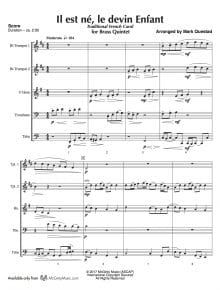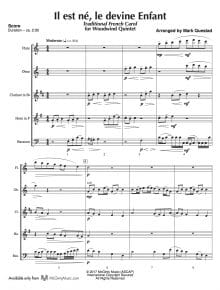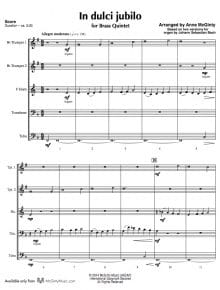Search Music
Music Categories
PDF Download Only
Purchase. Print. Play.
-
Il est né, le devin Enfant – Brass Quintet
Il est né, le devin Enfant, a French Christmas carol, occupies an unusual position between the secular and the sacred. Suitably, this instrumental version can find a place on different types of programs. A joyous carol, the text of the chorus tells us to celebrate by playing oboes and sounding bagpipes.
The mp3 excerpt is performed by the Sine Nomine Brass Quintet. (Used with permission.)
Composer: Mark Questad
Instrumentation: 2 Bb Trumpets, F Horn, Trombone & Tuba
Duration/# of Pages: ca. 3:40 / 13 pages, 8.5″ x 11″
Key: C-Db -
Il est né, le devin Enfant – Woodwind Quintet
Il est né, le devin Enfant, a French Christmas carol, occupies an unusual position between the secular and the sacred. Suitably, this instrumental version can find a place on different types of programs. A joyous carol, the text of the chorus tells us to celebrate by playing oboes and sounding bagpipes.
Composer: Mark Questad
Instrumentation: Flute, Oboe, Clarinet, F Horn & Bassoon
Duration/# of Pages: ca. 2:30 / 14 pages, 8.5″ x 11″
Key: C-Db -
Illusions – Mixed Quintet
Illusions make us think we are seeing something we’re not, a deception, which is quite magical; and this piece is based on magic.
The first movement, Wild Card, depicts the journey to find one’s own way in life. The individual parts go this way and that, sometimes at peace with decisions made and sometimes filled with the unease that comes with fear of the unknown.
A wizard can be someone clever and skilled, as a computer wizard, and can also be synonymous for obsessions, including bewitchment and enchantment. Wizardz, the second movement, gives every instrument its own voice within the ensemble, sometimes clever and skilled, sometimes filled with enchantment and motivation with a little sorcery for good measure. Juggling, the third movement, sonically juggles the sound back and forth, up and down among the players, trying to keep all the balls in the air at the same time.
The sample score shows the first page of each of the three movements. At this time there is no recording available.
Composer: Anne McGinty
Instrumentation: Flute, Clarinet, Alto Saxophone, Bass Clarinet & Tuba
Duration/# of Pages: ca. 10:15 / 62 pages, 8.5″ x 11″
Key: N/A -
In dulci jubilo – Brass Quintet
In dulci jubilo is a traditional Christmas carol from the Middle Ages, first appearing in a manuscript dating from c.1400. It has been arranged by many composers, including Michael Praetorius in the 1600s, Buxtehude, Franz Liszt and Norman Dello Joio, to name just a few. An English translation from the original text that alternated Medieval German and Latin by J. M. Neale became known as Good Christian Men, Rejoice.
Johann Sebastian Bach wrote a choral version (BWV 368), and a double canon (BWV 608) and chorale prelude (BWV 729) for organ. There is also a chorale prelude for organ based on a naive cradle-song version that was once used in the mystery plays held in churches at Christmas time. Although attributed to Bach, the cradle-song version (BWV 751) has never been authenticated.
This arrangement includes two versions, playable as one piece or separately, and begins with the cradle-song style. The simplicity as well as the imitation in the tuba pedal is quite charming and rather unexpected when compared to Bach’s usual complexity. The second version is based on the chorale prelude for organ and is a traditional postlude for Christmas services.
In the Complete Organ Works of Johann Sebastian Bach, edited by Edouard Nies-Berger and Dr. Albert Schweitzer, they state that the harmonizations of chorales were not usually written out as the figured bass was enough. These editors also assumed that Bach had a reason and suggest that he wrote them for his own satisfaction or, more likely, for use with his pupils in the course of instruction in thorough-bass playing.
Composer: Anne McGinty
Instrumentation: 2 BbTrumpets, F Horn, Trombone & Tuba
Duration/# of Pages: ca. 3:20 / 22 pages, 8.5″ x 11″
Key: F




